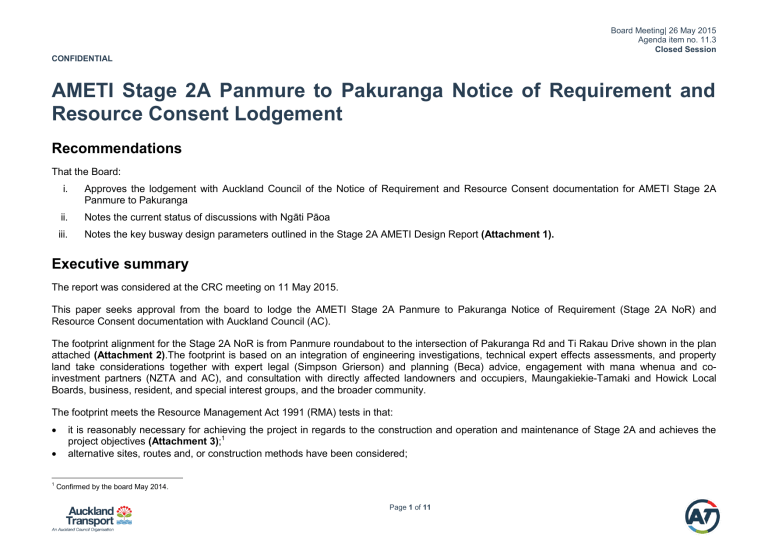AMETI Stage 2A Panmure to Pakuranga Notice of Requirement and

Board Meeting| 26 May 2015
Agenda item no. 11.3
Closed Session
CONFIDENTIAL
AMETI Stage 2A Panmure to Pakuranga Notice of Requirement and
Resource Consent Lodgement
Recommendations
That the Board: i. Approves the lodgement with Auckland Council of the Notice of Requirement and Resource Consent documentation for AMETI Stage 2A
Panmure to Pakuranga ii. Notes the current status of discussions with Ng āti Pāoa iii. Notes the key busway design parameters outlined in the Stage 2A AMETI Design Report (Attachment 1).
Executive summary
The report was considered at the CRC meeting on 11 May 2015.
This paper seeks approval from the board to lodge the AMETI Stage 2A Panmure to Pakuranga Notice of Requirement (Stage 2A NoR) and
Resource Consent documentation with Auckland Council (AC).
The footprint alignment for the Stage 2A NoR is from Panmure roundabout to the intersection of Pakuranga Rd and Ti Rakau Drive shown in the plan attached (Attachment 2) .The footprint is based on an integration of engineering investigations, technical expert effects assessments, and property land take considerations together with expert legal (Simpson Grierson) and planning (Beca) advice, engagement with mana whenua and coinvestment partners (NZTA and AC), and consultation with directly affected landowners and occupiers, Maungakiekie-Tamaki and Howick Local
Boards, business, resident, and special interest groups, and the broader community.
The footprint meets the Resource Management Act 1991 (RMA) tests in that:
it is reasonably necessary for achieving the project in regards to the construction and operation and maintenance of Stage 2A and achieves the project objectives (Attachment 3) ;
1
alternative sites, routes and, or construction methods have been considered;
1
Confirmed by the board May 2014.
Page 1 of 11
Board Meeting| 26 May 2015
Agenda item no. 11.3
Closed Session
CONFIDENTIAL
it reflects consideration based on the concept design, technical expert effects assessment, and expert legal and planning advice of the:
(a) effects (positive and adverse) generated by indicative construction methods, operation, and maintenance of the transport corridor;
(b) appropriate measures to avoid, remedy, or mitigate the effects; and
it adopts a conservative “envelope approach” to identifying and assessing actual and potential effects of the project.
The documentation has been reviewed by Auckland Transport’s (AT) external legal and planning advisers who confirm the documentation is in order for lodgement. The NoR documents will secure long term protection of the land (10 year lapse period) for the project. Lodgement secures interim protection over the land requiring anyone proposing developments which may hinder the project to first obtain AT’s approval.
The overall independent planning assessment (Beca) is that with appropriate mitigation secured through conditions adverse environmental effects can be mitigated. There are, as with any large project, a number of key issues for the board ’s attention including non-scheduled tree removals, cultural impacts on Mokoia P ā and Mauinaina Pā (Attachment 2) , archaeological and heritage effects (the swivel section of the first Panmure
Bridge), visual impact of the soil nail wall, and social impacts (Lagoon View Kindergarten).
There has been extensive and on-going liaison with mana whenua throughout the AMETI project through regular hui. Ng āti Pāoa has been appointed by mana whenua to lead engagement, and has agreed to a process to advance matters through April and May to a sufficient point that, subject to board approval, Ng āti Pāoa are comfortable that the application can be lodged. Since November 2014 hui have also been held between the chief executive, the project sponsor, and Ng āti Pāoa kaumātua to specifically progress Mokoia Pā/Mauinaina Pā options based on advice and recommendations from AT’s cultural values expert.
Briefings have been provided to the Maungakiekie-Tamaki and Howick Local Boards on a regular basis (ranging from monthly to quarterly) since
2011. The local boards are supportive of the project, and have identified that the overall AMETI programme is a key priority and critical to the development of the local communities and businesses, and is of regional and national importance.
Strategic context
The key documents which provide the strategic context for AMETI Stage 2A are:
Auckland Plan
Statement of Intent Programme of Action (2014-2017)
The New Zealand Transport Strategy (2011-2021)
Page 2 of 11
Board Meeting| 26 May 2015
Agenda item no. 11.3
Closed Session
CONFIDENTIAL
Background
One NoR for AMETI Stage 2A Panmure to Pakuranga encompasses all proposed works from Panmure roundabout to the Pakuranga/Ti Rakau intersection, with the exclusion of the proposed new Panmure Busway Bridge. As a requiring authority cannot designate over water, the new bridge structure will require a coastal permit.
Resource consents are being sought for regional consents matters such as stormwater disposal, erosion and sediment control and earthworks. These include the section from Panmure roundabout along Lagoon Drive to Panmure Bridge, and the eastern abutments of the bridge. Additional resource consents for the Pakuranga Busway section from the eastern end of Panmure Bridge to the Ti Rakau intersection will be lodged with AC upon completion of the final technical investigations relating to the Coastal Marine Area (CMA).
The key design parameters of the busway are illustrated in the AMETI Stage 2A Design Report circulated at the March Board meeting ( Attachment
1 ).
Issues and options
Tree removal and ecological impacts:
The proposed alignment protects scheduled pohutukawas along the southern side of Lagoon Drive which are of significant community and cultural value. No scheduled trees will be removed. Landscape mitigation and substantial replacement planting under the proposed Landscape Plans will mitigate the effect of removal of 86 trees along the alignment which are subject to general tree protection controls. Constraints from the current road alignment, the existing Panmure Bridge, and highly significant cultural/archaeological/geological areas adjoining the road corridor mean the identified removals are unavoidable. Public consultation to date has not raised any issues regarding tree removals. Neither the Maungakiekie-Tamaki and
Howick Local Boards nor AC Parks have expressed any concerns regarding the proposed removals.
Cultural Impacts on Mokoia Pā and Mauinaina:
A cultural values assessment (CVA) of the alignment has been prepared by cultural values expert Tama Hovell. The assessment outlines the importance of the Mo koia Pā/Mauinaina site ( Attachment 2 ) to mana whenua and in particular th e history and cultural identity of Ngāti Pāoa. To ensure the Further Options Assessment (FOA) took account of this, cultural values criteria were included as part of the multi criteria analysis.
In response to the cultural significance of the area to the south of Lagoon Drive adjoining Panmure Basin, a northern alignment for the new busway and bridge was selected. Any movement to the south would impact significantly on cultural values of Ngāti Pāoa as the pohutukawa located there have special significance. In addition the area to the south is listed in AC’s District Plan as a scheduled archaeological and geological site.
A number of design measures have been incorporated to respond to the cultural values impacts, together with mitigation and remediation measures within a comprehensive suite of draft conditions. The package of measures responds to the cultural impacts. In addition discussions are on-going between the Chief Executive and Ng āti Pāoa kaumātua regarding opportunities to progress broader arrangements between the organisations. These discussions will continue post lodgement.
Page 3 of 11
Board Meeting| 26 May 2015
Agenda item no. 11.3
Closed Session
CONFIDENTIAL
Archaeological and Heritage
There are five recorded archaeological sites and two scheduled heritage sites within and adjacent to the project footprint; Mokoia Pā (1820’s), the
Panmure Stockade (1860’s), burial sites, midden (cliff edge Sunset View Road), the Panmure roundabout, the swivel section of the first Panmure
Bridge (1864/65) and the Panmure Lagoon edge (Headland P ā; middens; flooded explosion crater and tuff ring).
With regard to the swivel section of the first Panmure Bridge, it is proposed to demolish the marina building which surrounds (and partly supports) the swivel section in order to allow for the construction of the new bridge. This will mean the swivel section will be visible. An appropriate conservation plan will be put in place to avoid damage and deterioration during and after construction. The new bridge is proposed to pass over part of the swivel section, with a clearance of approximately 3-5m, and it is anticipated that this provides adequate clearance to enable future reconstruction of the former suspension structure.
An authority from Heritage New Zealand will be applied for, prior to construction, so that any archaeological remains encountered within the project area can be managed appropriately in accordance with statutory requirements, and the swivel section appropriately protected during and after construction.
Landscape and Soil Nail Wall
The soil nail wall (located on northern side of Lagoon Drive with heights ranging from 2m – 12m) results from the northern shift of the alignment to avoid impacts on established pohutukawa trees and avoiding adverse effects within the Outstanding Natural Feature of the Panmure Basin as shown on Proposed Auckland Unitary Plan (PAUP) planning maps (Attachment 4).
There will be visual effects from the soil nail wall particularly at the highest section of the wall at Sunset Reserve and at the Church Crescent end of
Lagoon Drive. These effects will be mitigated by rock bolt patterning and incorporation of planting into the wall.
Social
The identified adverse short term social effects can be appropriately mitigated through implementation of the proposed Communications Plan. Once operational, the long-term social effects are likely to be positive. Lagoon View Kindergarten (23 Domain Drive) is occupied under a tenancy which terminates on 30 June 2016. Prior to entering into the lease in November 2012 the kindergarten were advised that they would be required to vacate upon formal notice for the construction of the Stage 2A works. Formal engagement will be undertaken with the kindergarten.
Other issues
The current design responds to a number of the concerns, including several intersection design changes, amended property accesses from Domain
Road to several properties that currently have access from Lagoon Drive, lane configurations on Pakuranga Road and accesses to Panmure businesses on Queens Road via Korma Lane and residential areas served by Williams Avenue and Tamaki Bay Drive and commuter parking impacts. Submissions are expected from these stakeholders and on-going discussions will be held to attempt resolution of any on-going concerns.
Page 4 of 11
CONFIDENTIAL
Next steps
Subject to board lodgement approval;
Public notification July/August 2015;
On-going consultation (stakeholders, directly affected and in proximity owners/occupiers, mana whenua hui, local boards);
Submission period (20 working days);
Hearing date anticipated in the first quarter 2016;
Recommendation from independent commissioners on NoR and decision on consents;
AT decision on the NoR;
Appeal period (15 working days).
Board Meeting| 26 May 2015
Agenda item no. 11.3
Closed Session
Attachments
Attachment Number
1
2
3
4
Description
Stage 2A AMETI Design Report
Overall Footprint for AMETI Stage 2A Panmure to Pakuranga and Mokoia/ Mauinaina Pā map
AMETI Stage 2A Project Objectives
Outstanding Natural Feature of the Panmure Basin PAUP planning map
Page 5 of 11
CONFIDENTIAL
Document ownership
Submitted by
Recommended by
Approved for submission
Graeme Michie
Team Lead AMETI Planning Workstream
Aimee Barwick
Planning Integration Manager
Deb Godinet
Group Manager Property & Planning
Peter King
AMETI Programme Director
John Worth
Group Manager Investment & Development
Greg Edmonds
Chief Infrastructure Officer
David Warburton
Chief Executive
Board Meeting| 26 May 2015
Agenda item no. 11.3
Closed Session
Page 6 of 11
CONFIDENTIAL
Glossary
Acronym
AMETI
AC
CRC
CVA
FOA
NoR
PAUP
RMA
Description
Auckland Manukau Eastern Transport Initiative
Auckland Council
Capital Review Committee
Cultural Values Assessment
Further Options Assessment
Notice of Requirement
Proposed Auckland Unitary Plan
Resource Management Act 1991
Board Meeting| 26 May 2015
Agenda item no. 11.3
Closed Session
Page 7 of 11
AMETI Stage 2A Panmure to Pakuranga Notice of Requirement and
Resource Consent Lodgement - Attachment 1
AMETI
Stage 2A Design Report
Key Facts
• 2.4km of 2 way urban busway
• 1.3km of 4.0m+ wide shared walking and cycling path
• 1.1 km of separated walking and cycling paths
• 7 significant retaining walls up to 14m high
• 9 intersections modified/upgraded
( incl. Panmure Roundabout)
• 3 span steel girder bridge
(73.5m central span, 66.5m side spans)
• Stormwater design to PAUP standards
• ATCOP/Austroads/NZTA/ANZS standards
2
Design Status
Panmure
Roundabout
Lagoon Drive BW
Panmure Bridge
Pakuranga Road BW
Scheme
Prelim
(Specimen)
N
O
R
Detailed Documentation
(possible D&C)
(included in current contract)
(included in current contract)
3
Design Principles
• Design Frequency of 1 Bus per minute
• Maximum reliability - Min. stops & Intersections
• Bus signal priority/pre-emption
• Max vert. grade 6% (compatible with light rail)
• New design vehicles - 13.5m single, 12.6m single,
12.5m double decker (min. outer turn radius 12.85m)
• Design speed 60 km/h
• Light rail standards requested
4
Existing Environment
5
Panmure Roundabout
6
Proposed Panmure Signalised
Intersection
7
Lagoon Drive Busway
8
Lagoon Drive Busway
9
Soil Nail Wall
(14m max height)
Proposed Basin View Lane
Intersection
10
Soil Nail Wall
Proposed Panmure Bridge
11
Proposed Panmure Bridge
12
Pakuranga Road Busway
13
Proposed Pakuranga Road Busway
14
Proposed Kerswill Place Intersection
15
Proposed Ti-Rakau Tie In
16
Network Changes
Proposed road closure
Proposed new access road
17
Key Design Consenting Risks
• Mokoia Pa – mitigation agreed
• Panmure Bridge final location (north/south position outstanding)
• Pakuranga busway retaining wall (coastal marine consent)
• Bus connectivity to Panmure town centre (not resolved by this application)
• Shared vs. separated cycle path (appropriateness)
• Desirable lane widths adopted (some compromise at pinch points)
• Panmure Bridge southern abutment consents (constructability, erosion and sediment control and CMA consents to be included)
• Construction effects and adequate mitigation
• Acquisitions for constructability purposes
18
Physical Works Cost Estimate
Pan R’bt Lagoon Dr
$21.8M $22.6M
Note: update to estimates currently in progress
Pan Bridge
$29M
Pak. Rd
$14.4M
19
CONFIDENTIAL
Board Meeting| 26 May 2015
Agenda item no. 11.3
Closed Session
Attachment 2 - Overall Footprint for AMETI Stage 2A Panmure to
Pakuranga and Mokoia/ Mauinaina P ā
Map
The blue outline is the NoR footprint the red and yellow lines refer to Mokoia Pā
.
The red lines are an interpretation based on combined historical/archaeological information of the defences of Mauinaina Pā.
The yellow lines show surveyed locations of defences as at 1846.
Ngāti Pāoa record Mokoia Pā as the headland pā at the entrance of the lagoon and Mauinaina is on the hill. Ngāti Pāoa note that the whole district around the lagoon was also known as Mokoia.
Page 9 of 11
Board Meeting| 26 May 2015
Agenda item no. 11.3
Closed Session
CONFIDENTIAL
S2
S3
S4
S1
S5
S6
S7
Attachment 3 - AMETI Stage 2A Project Objectives
Specific AMETI Stage 2A Project Objectives
To contribute to place shaping in Panmure and Pakuranga town centres by providing better connections and accessibility between and within these centres for all transport users, including public transport users, pedestrians and cyclists.
To provide transport infrastructure that integrates with land uses and supports a quality compact urban form in Panmure and Pakuranga.
To provide transport infrastructure that improves linkages, relieves network constraints and improves journey time, frequency and reliability of the transport network overall.
To improve the efficiency and resilience of the transport network between Panmure and Pakuranga by providing a dedicated route for public transport to and from the eastern suburbs.
To maximise the benefits of investment in transport infrastructure by extending network connections and delivering network improvements
To provide a multi modal transport corridor that connects Panmure and Pakuranga to increase access to a choice of transport options
To create a corridor that is safe for all road users, including public transport passengers, cyclists and pedestrians
Page 10 of 11
Board Meeting| 26 May 2015
Agenda item no. 11.3
Closed Session
CONFIDENTIAL
Attachment 4 - Outstanding Natural Feature of the Panmure Basin PAUP planning map
Page 11 of 11



